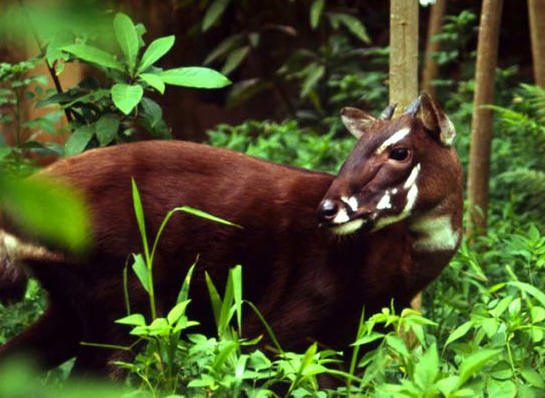In May 1992, Vietnamese and Foreign Biologists were taken by surprise by the discovery of three pairs of horns. These were horns of trophies killed by the local people of central Vietnam’s Vu Quang Nature reserve. The biologists were on field survey in the area. The size of the horns suggested about the existence of a large animal completely unknown to the outside world.
This discovery took the science community by shock. It was believed that after centuries of exploration by explorers across deserts, rainforests of the planet with even high technology left no place or large species unkown to the science.
After this discovery, scientists did extensive research in the area. In next few years this research led to the discovery of 20 partial specimen of this species, including three complete skin and several photos. Researchers were also able to trap the species in remotely set camera in the rain forests. With all these evidences, scientists came to the conclusion that this is a completely new species and it was named as Saola (Pseudoryx nghetinhensis).
Saola was name already local people have been referring to this animal . Sao means Spindle and La means post. The generic name Pseudoryx , of the species refers to slightly curved, backward-sweeping horns, resembling to those Oryxes found in Africa and Arabia. Saola is very distantly related to these arid-adapted antelopes though. The specific name of the scientific name refers to efers to the two Vietnamese provinces Nghe An and Ha Tinh close to where it was found.
The saola stands about 85 cm at the shoulder and weighs approximately 90-100 kg. The coat is a dark brown with a black stripe along the back. Its legs are darkish and there are white patches on the feet, and white stripes vertically across the cheeks, on the eyebrows and splotches on the nose and chin. All saolas have slightly backward-curved horns, which grow to half a meter in length. The genetic analysis reveals that it is a primitive member of the cattle family.
All known locations for the species are mountainous with steep river valleys, covered by evergreen or semideciduous forests between 300 – 1800 m (1000 – 6000′), with low human disturbance. It is only found in the foothill of the Tuong Son range. Its distribution within this known ranges is uneven and fragmented in small patches. This range occurs in the border between Laos and Vietnam. It stays in the higher elevations during the wetter summer season, when streams at these altitudes have plenty of water, and moves down to the lowlands during the winter, when the mountain streams dry up.
Even after two decades of discovery, very little known about this large mammal. In the discovery article of Saola, the team proposed a three months survey to observe the living animal. But Even after intense efforts, scientists have not been able to see a Saola in wild in its natural setting yet! Most of the information on the Saola is gathered from photos and local people’ knowledge.
Local people have reported having seen saola traveling in groups of two or three, rarely more. Villagers say that the ox eats the leaves of fig trees and other bushes along riverbanks. Saola mark their territories by opening up a fleshy flap on their snout to reveal scent glands. They subsequently rub the underside against objects leaving a musky, pungent paste. The saolas’ colossal scent glands are thought to be the largest of any living mammal.
Though very little known about Saola, one thing is certain that its in a very critically threatened state. In 1994 IUCN listed the species as “Endangered”. But in 2006 its given “Critically Endangered” status due to reducing population. The animal can’t survive in captivity. All efforts to keep in captivity have failed, the latest being late August 2010. A Saola was captured by villagers in Laos but died in captivity before government conservationists could arrange for it to be released back in to the wild.
The actual size of the remaining population is unknown and its rarity, distinctiveness and vulnerability make it one of the greatest priorities for conservation in the region. The current population is thought to be a few hundred at maximum and possibly only a few dozen at a minimum.
In April 2011, a reserve was declared to help protect saolas. The Quang Nam’s People Committee inaugurated the Quang Nam Saola Nature Reserve in the Annamite mountains along the border of Vietnam and Laos. This recent development has created hope for this extremely rare mammal in the world.




Recent Comments